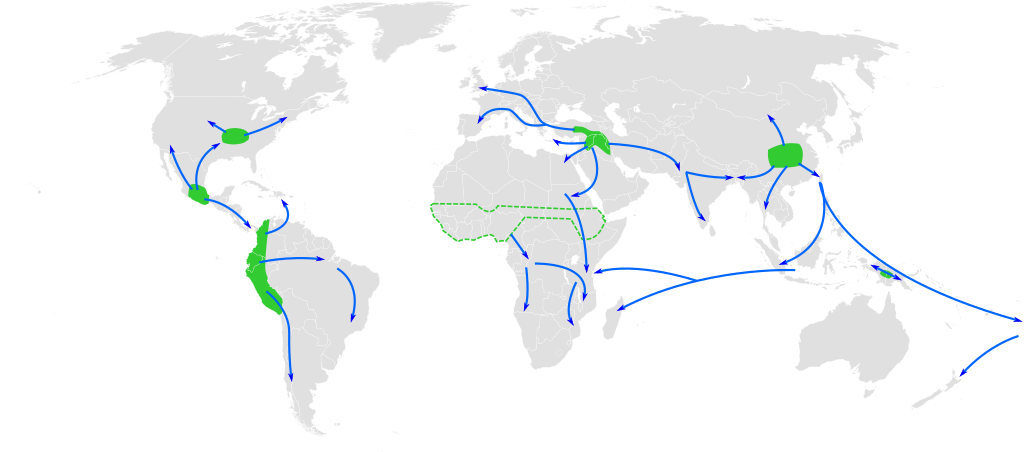
Spread of farming and farmers.
Humans, the genus Homo, evolved in Africa. For most of the history of our genus, even for most of the history of our species Homo sapiens, we were foragers in Africa.
Homo sapiens are probably about 300,000 or so years old as a species. We did not leave Africa until maybe 80,000 years ago, with another exit wave about 50,000 years ago. Our species then spread out, still being foragers, across every continent except Antarctica.
Around 10,000 years ago, some of our ancestors started farming. Farming was invented again and again. In each case, farmers spread out, absorbing and replacing (mostly replacing) foragers. Some foraging populations have persisted to the present day. Those populations have no history other than being foragers. But they are a tiny proportion of present day humans.
The genetic record suggests that farming (and a bit later pastoralism) sped up human evolution, rather than slowing it down. It sped it up because it changed the selection pressures dramatically. Farming was distinctly less healthy than foraging, but massively increased our access to usable calories, and so won the demographic struggle against foraging.
What were the effects of these changes? Many and varied. Among pastoralist populations, lactase persistence, the ability to consume milk as adults, evolved. It also seems that our normative capacity evolved, with a shift towards moral norms because that made group stability easier and so enabled us to operate in larger (and more hierarchical) groups.
It also, fairly clearly, increased the variety of our response to food. Different populations had systematically different food patterns and selection pressures from those food patterns.
Where does that leave us?
Understanding that the notion of nutrition guidelines, especially enforced nutrition guidelines, is a complete crock. First, humans are simply too varied in their responses to food for a one-size-fits-all set of nutrition guidelines to be sensible.
Human responses to nutrition will not be random, just varied. So, responses will be distributed, probably in a fairly normal Bell-curve pattern (though that is a guess, not an inference from clear evidence). Thus, there will be patterns, potentially strong ones, in human responses to nutrition. Though the patterns are still likely to be varied enough that one-size-fits-all guidelines are still going to be a bad idea.
That 10,000 years or so of farming experience (which in many populations is rather less than that), is hardly going to completely overwrite 300,000 years of experience of being foragers (plus all that prior evolution). With even those foragers had significant variety in their diets between groups.
But those patterns are unlikely to be remotely uniform enough to make nutrition guidelines useful as anything more than a very general guide for people to discover what works for them.
The other problem with nutrition guidelines is (1) nutrition science is difficult and (2) the chances of government nutrition guidelines being solidly based on good nutrition science are vanishingly small.
Nutrition science is difficult because our responses to food are somewhat varied, our food intake is very varied and food is not remotely the only thing that affects our health and longevity. So, trying to tease out the effects of different foods, different food groups, different eating patterns, on our health and longevity is inherently complex and so inherently difficult.
The sheer difficulty of doing good nutrition science actually makes problem (2) worse. If it is hard to do good nutrition science, it is easy to do it badly. If it is easy to do it badly, it is very easy to do it to support an agenda. There are massive income flows at stake in food, nutrition and health, so there are massive social selection pressures in play to support, sustain and expand access to those income flows.
Which is how we have ended up, across the Western world, with nutrition guidelines that clearly do NOT promote health and active longevity. That, on the contrary, are presiding over us collectively getting chronically sicker, particularly through the dramatic increases in metabolic syndrome, as that is what maximises income flows to a lot of interested parties.
Big Food Products that wants us to eat more and more, to eat to our (manipulated) palates not to our health. Big Pharma that wants to sell symptom suppression drugs so makes more money the more symptoms there are to suppress. Ordinary medicos who make more money prescribing symptom suppression drugs to the chronically metabolically ill. Big Health Advocacy whose income comes from Big Food Products and Big Pharma and who get more income and importance the bigger their issue is. Big Government Health Bureaucracies, whose revenues go up the more chronically sick we collectively are.
With all those selection processes at work, the likelihood of nutrition guidelines being actually based on the science and actually promoting health and active longevity is close to zero. As we have collectively experienced.
And this without considering the ideological pressures also in play, such as religious and other commitments to vegetarianism.
Government nutrition guidelines have been a serial disaster and were never a good idea in the first place. Our metabolisms were collectively much healthier when we were not afflicted with government nutrition guidelines.
Humans are too nutritionally varied, and the social selection processes operating on bureaucracies and political processes far too perverse, for government nutrition guidelines to be an idea that anyone should support.


No comments:
Post a Comment